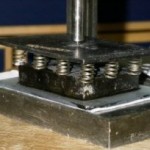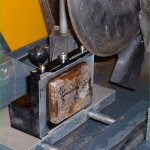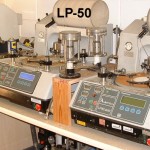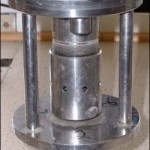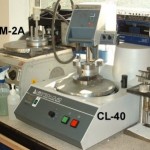The processing of polyester crystic resin impregnated soil samples into soil thin section slides is effectively a 5 stage process, bonding to a slide, cutting off excess, grinding to desired thickness, polishing and finally coverslipping.
- Bonding soil block to slide
 : The impregnated soil block is cut with an abrasive cutter (Buehler Petrocut) into approximately 1cm thick slices. Each slice is ground on the lapping plate (LP40/50) using 15 µm calcined aluminium oxide in water (or in the case of clay or peat in ethylene glycol). This is to ensure a flat uniform surface for bonding to the slide. The sample slice is then bonded to a glass slide with an etched surface using 301 epoxy resin. This is clamped overnight in spring mounted jigs to ensure a good sample/slide bond and to minimise the thickness of the epoxy resin layer.
: The impregnated soil block is cut with an abrasive cutter (Buehler Petrocut) into approximately 1cm thick slices. Each slice is ground on the lapping plate (LP40/50) using 15 µm calcined aluminium oxide in water (or in the case of clay or peat in ethylene glycol). This is to ensure a flat uniform surface for bonding to the slide. The sample slice is then bonded to a glass slide with an etched surface using 301 epoxy resin. This is clamped overnight in spring mounted jigs to ensure a good sample/slide bond and to minimise the thickness of the epoxy resin layer. - Cutting off the excess: The next day excess material is cut off using an abrasive cutter. Depending on the machinery used care should be taken to cut off as much material as possible without damaging the slide.
- Grinding: The slide is now ready to be lapped on the LP40/50 machines. The thickness of the glass is measured using a micrometer. The target thickness for a sample is 30-40 µm therefore this is added to the slide thickness plus an undercut value of 30 µm which gives the total setting for the lapping jigs (PLJ2). Slides are held in the PLJ2 jigs by means of a vacuum so it is important to keep the surface of both the jig and the slide clean and free from debris. The LP40/50 machines have a cast iron radial grooved plate and the grinding medium is drip fed onto the plate. The majority of soil samples are lapped with 15 µm calcined aluminium oxide in water except in the case of clays or highly organic samples where ethylene glycol is usedin place of water. The time taken to lap a sample to it’s target thickness is dependent upon the starting thickness, the hardness of the material and whether water or ethylene glycol is used. In general most samples can be lapped to completion in anything between one to 5 hours. Samples are checked for thickness towards the end of the lapping process using a microscope to determine the colour of quartz grains under crossed polarised light. For a thickness of 30 – 40 µm they will appear pale to light yellow.
- Polishing: When the desired sample thickness has been achieved the slides are next polished on the CL-40 polishing machine with 3 µm diamond in oil suspension. Slides are then cleaned with a non solvent cleaner to remove any residual oil.
- Coverlipping
 :The final stage is to coverslip the completed slide to protect the surface from damage. The coverslip is bonded to the slide using Epotek 301 epoxy resin and placed in the bonding jig overnight
:The final stage is to coverslip the completed slide to protect the surface from damage. The coverslip is bonded to the slide using Epotek 301 epoxy resin and placed in the bonding jig overnight
